Radio Shack 2101679A 40-Ch 4W Handheld CB Radio with Weather Alert User Manual Usersanual
RadioShack Corporation 40-Ch 4W Handheld CB Radio with Weather Alert Usersanual
Contents
- 1. Usersanual
- 2. Users manual
Usersanual
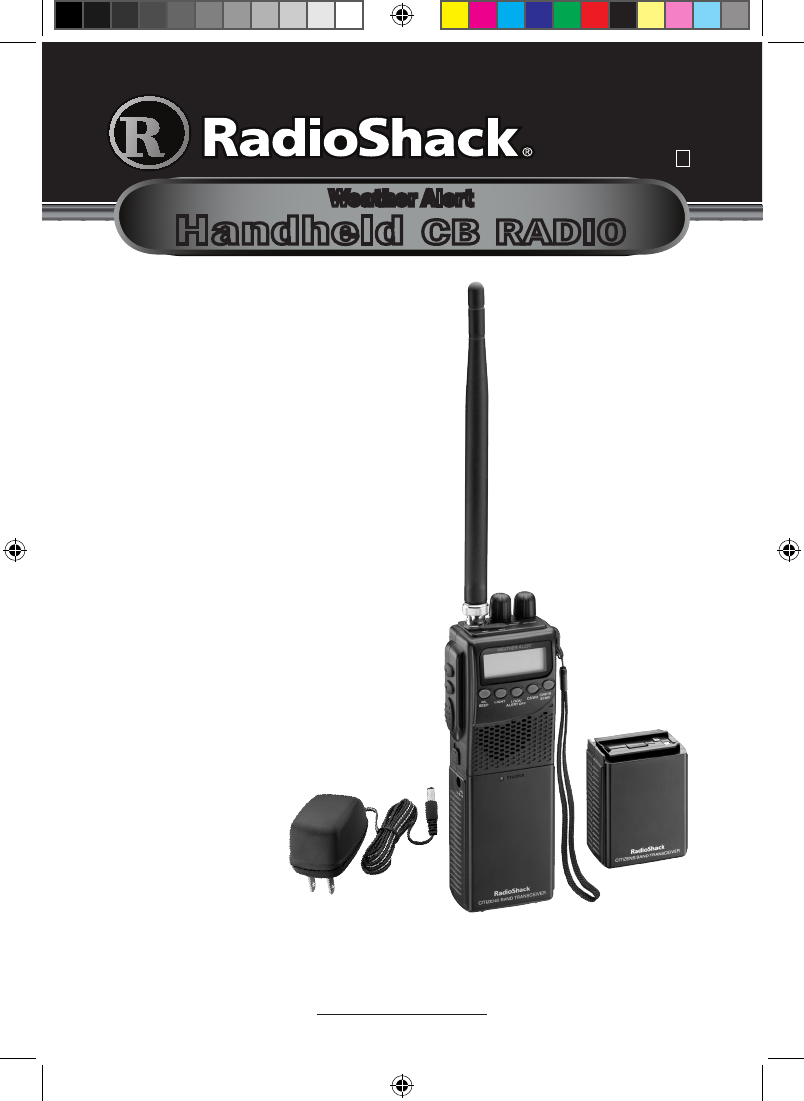
21-1679 A
Please read this user’s guide before installing, setting up
and using your new CB radio.
www.radioshack.com
Thank you for purchasing your
Weather Alert Handheld CB
Radio from RadioShack.
What’s Included
CB Radio
Ni-MH Battery Pack
AA Battery Case
AC Charger
Antenna
Hand Strap
Belt Clip
User’s Guide
FCC Rules
Weather Alert
Handheld CB RADIO
21-1679A_En_111207.indd 1 11/12/2007 17:32:48
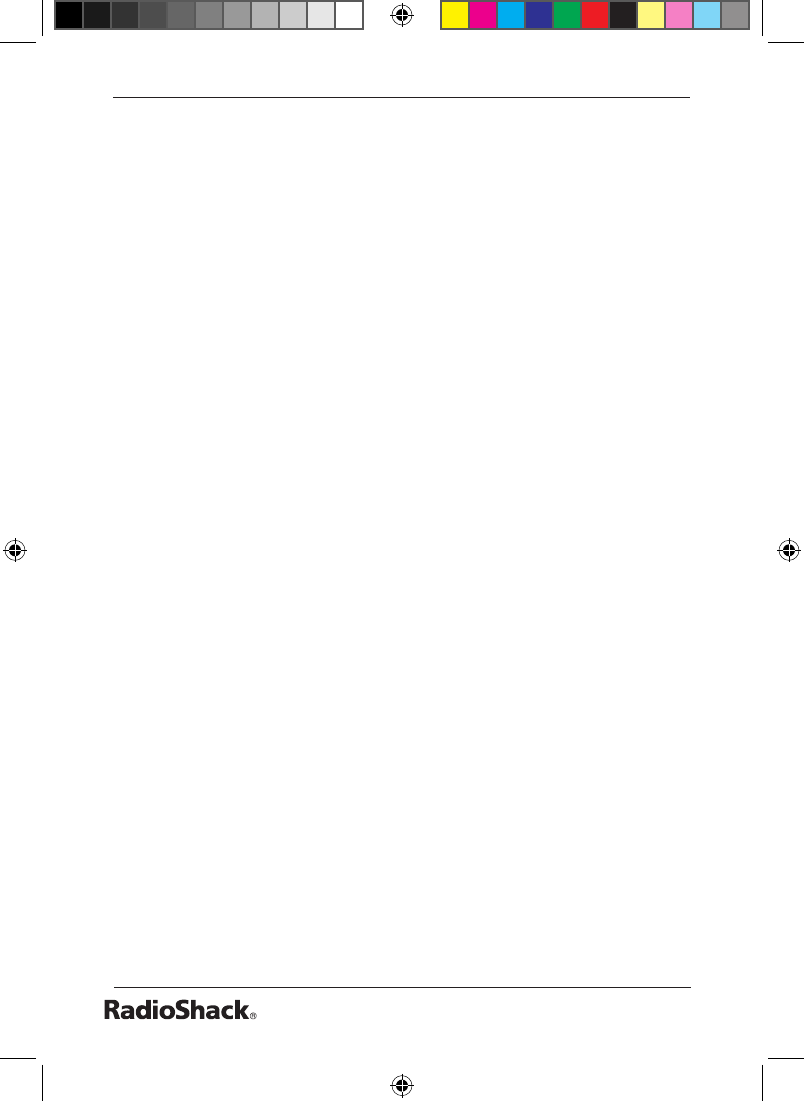
2
Contents
A Look at Your CB Radio ........................................................3
Powering Your CB Radio ........................................................4
Using the Ni-MH Battery Pack ...............................................4
Recycle Rechargeable Batteries ....................................... 5
Using the AA Battery Case ....................................................5
Using AC Power ....................................................................6
Using Vehicle Power ..............................................................7
Connecting Your CB Radio .....................................................8
Installing the Antenna ...........................................................8
Installing an Optional Antenna .............................................8
Connecting an External Speaker or Microphone ..................8
Operating Your CB Radio .......................................................9
Receiving ...............................................................................9
Transmitting ...........................................................................9
Safety Precaution ........................................................... 10
Settings ...............................................................................10
High/Low Power Level ................................................... 10
Backlight ........................................................................ 10
Key Tone ........................................................................ 10
Key Lock ........................................................................ 11
Power Save .................................................................... 11
Scanning Channels ..............................................................11
Using Channels 9 and 19 ....................................................11
Listening to the Weather Band ...........................................12
Listening to a Weather Channel .................................... 12
Turning Digital Weather Alert On and Off ..................... 12
Understanding Digital Weather Alert ............................ 13
Additional Information .........................................................14
Legal Use of Your CB Radio ................................................14
Common Uses for a CB Radio .............................................14
Transmission Courtesy .........................................................14
Transmission Range .............................................................14
Common 10-Codes .............................................................15
Frequency Range ................................................................16
Specications .......................................................................17
Care .....................................................................................17
RF Emissions Information .....................................................18
Do Stuff ...............................................................................19
Limited 90-Day Warranty .....................................................20
21-1679A_En_111207.indd 2 11/12/2007 17:32:48
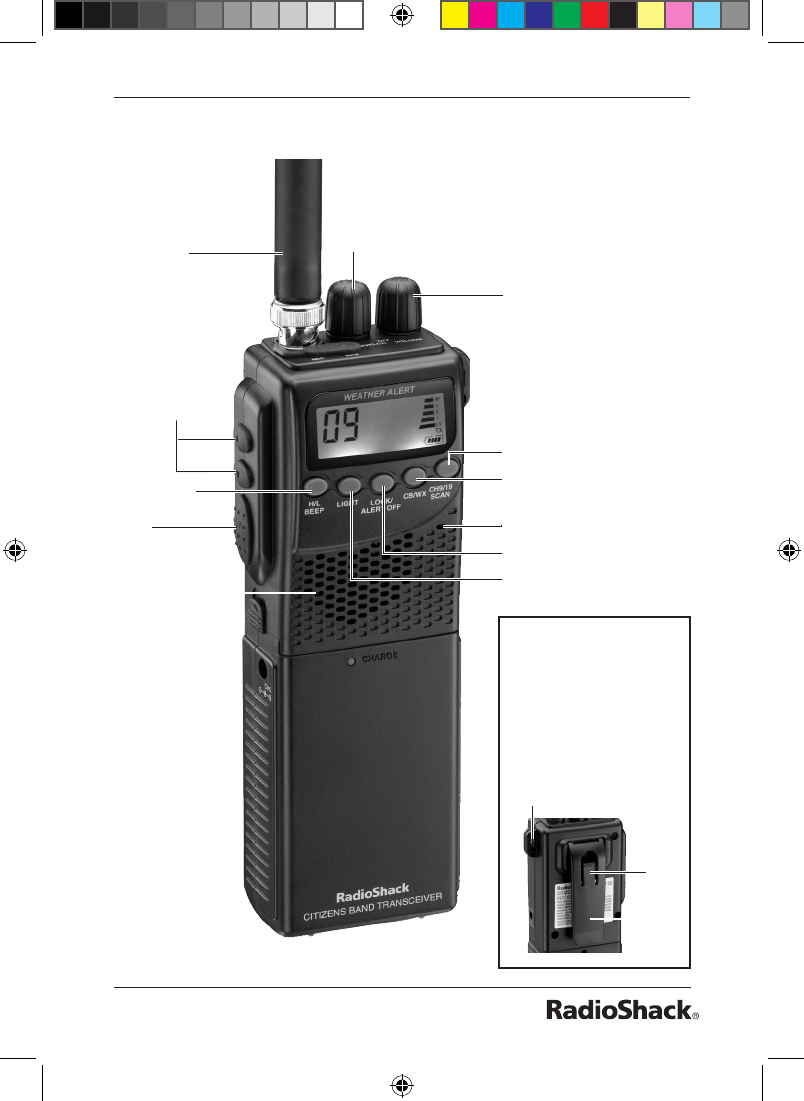
3
A Look at Your CB Radio
OFF/VOLUME
SQUELCH
Antenna
Channel
Selection
Buttons ▲/▼
PTT
(Push to Talk)
CH9/19 SCAN
CB/WX
LOCK/ALERT OFF
LIGHT
Internal
Speaker
H/L BEEP
Attaching the Belt Clip
To attach the belt clip,
slide it up until it locks
into place.
To remove the belt clip,
pull the tab and slide
the belt clip down.
Tab
Hand Strap Hole
Belt
Clip
Internal Microphone
21-1679A_En_111207.indd 3 11/12/2007 17:32:50
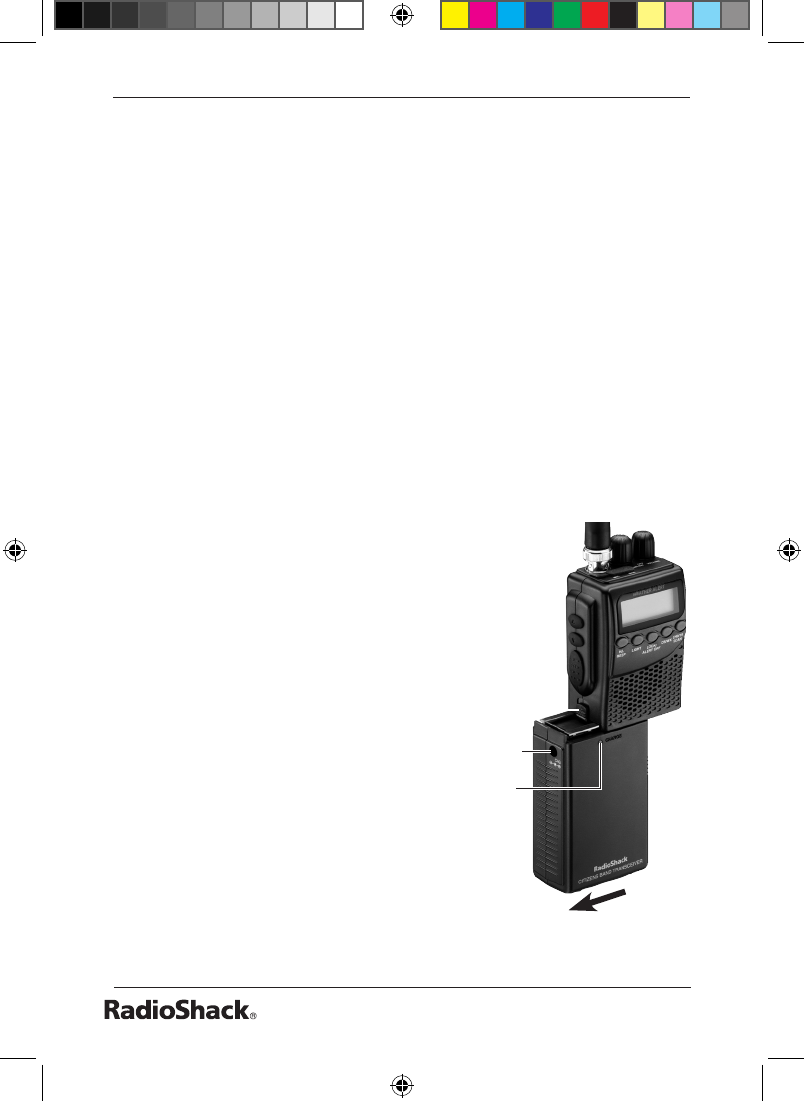
4
Powering Your CB Radio
You can power your CB radio from one of these four sources:
• The rechargeable Ni-MH battery pack
• Eight AA batteries (not included) using the supplied battery
case
• AC power using an AC-to-DC power supply (not included)
• Vehicle power using a DC power cord (not included)
Using the Ni-MH Battery Pack
Charge the Ni-MH battery pack (using the supplied AC charger)
for about 18 hours prior to using it for the rst time. Afterward,
it takes 14-16 hours to charge the battery pack when it is fully
discharged.
You can charge the battery pack while it is installed or removed.
But the CB radio does not work during charging.
To charge the battery pack:
Connect the AC Charger to the
CHG Jack, then plug it into an AC
outlet. The CHARGE Indicator
lights red and charging starts.
Note: The supplied AC charger
is for charging only, not for
directly powering the CB.
To install the battery pack:
Slide the battery pack onto the
CB radio until it clicks. The battery
pack ts onto the CB radio only
one way. Do not force it.
To remove the battery pack, slide
the battery pack in the arrow
direction while holding up the
latch.
Cautions:
• To avoid injury, do not connect
Latch
CHG Jack
CHARGE
Indicator
Slide to remove
battery pack
21-1679A_En_111207.indd 4 11/12/2007 17:32:51
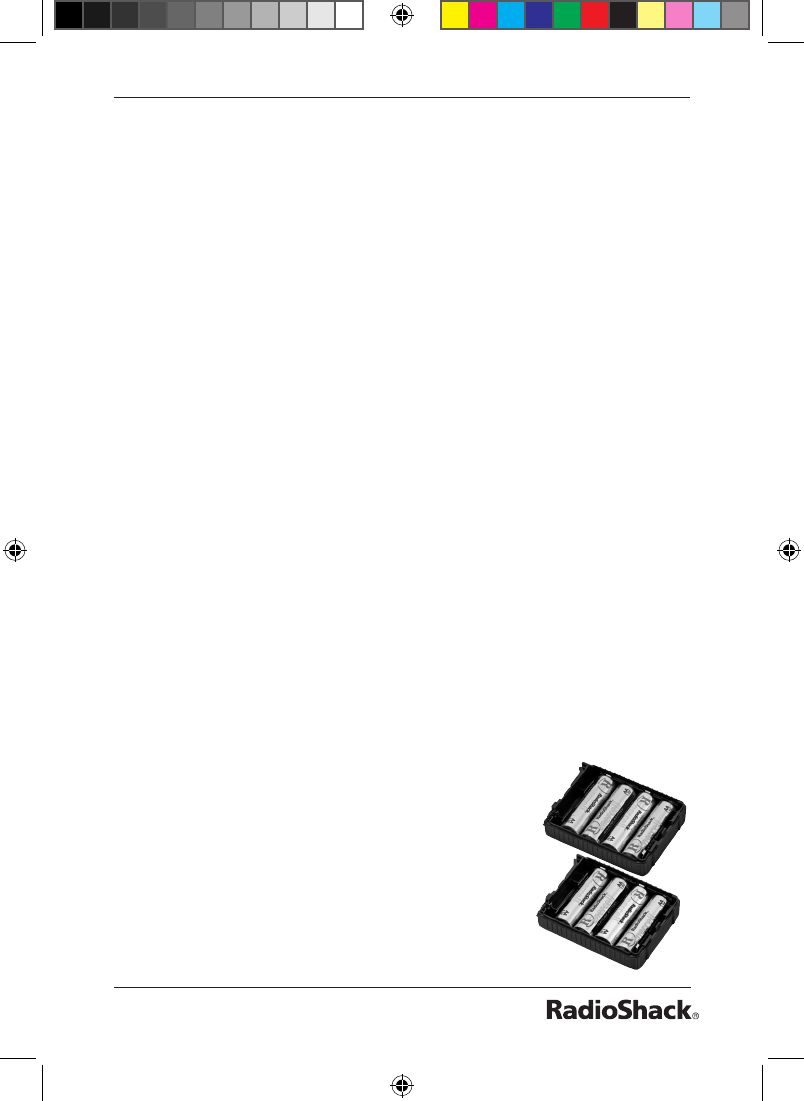
5
the AC charger to a ceiling outlet. After charging, disconnect
the AC charger.
• You must use a Class 2 power supply that provides 16V DC
and delivers at least 200mA. The barrel plug’s center must
be positive and the barrel plug must t the CB’s CHG jack.
The supplied AC charger meets these specications. Using
an adapter that does not meet these specications could
damage the CB radio or adapter.
• Always connect the AC charger to the battery pack before
you connect it to an AC outlet, and disconnect the AC
charger from the AC outlet before you disconnect it from the
battery pack.
• Overcharging your battery pack could shorten its life.
• Do not charge your battery pack at temperatures below 14°F
(–10°C) or above 131°F (55°C).
• You cannot recharge the Ni-MH battery pack using DC
power.
Recycle Rechargeable Batteries
Placing rechargeable batteries into the trash or the municipal
waste system can be harmful to the environment and may be
illegal in your area. RadioShack participates in an industry
program to collect and recycle rechargeable batteries at the end
of their useful life.
You can return your rechargeable batteries to your local
RadioShack store for recycling (at no cost to you). Or call
1-800-THE-SHACK (1-800-843-7422) for information on
rechargeable battery recycling in your area. RadioShack’s
involvement in this program is part of the
company’s commitment to preserving our
environment and conserving our natural
resources.
Using the AA Battery Case
1. Turn off the CB radio if it is on.
2. Pull the halves of the case apart to open
it. Insert eight AA batteries, matching
21-1679A_En_111207.indd 5 11/12/2007 17:32:52
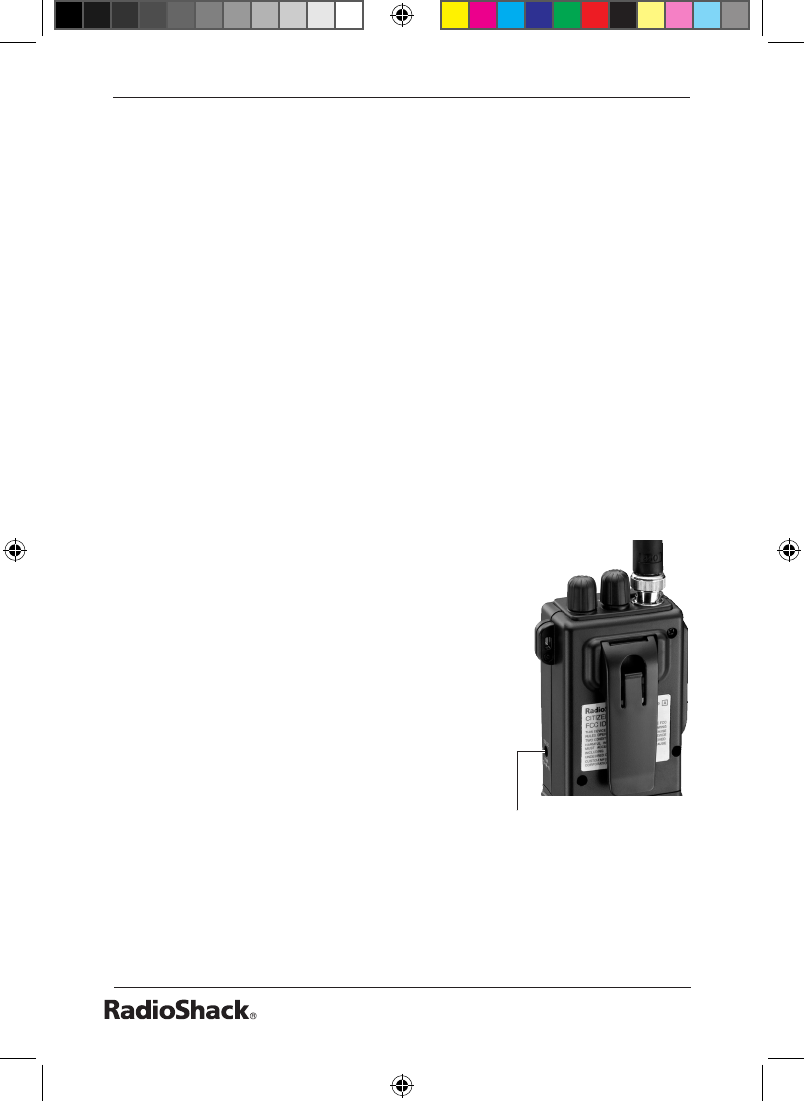
6
the polarity marks (+ and –). Snap the halves of the case
together to close it.
3. Slide the battery case onto the CB radio until it clicks. The
battery case ts onto the CB radio only one way. Do not
force it.
Replace the batteries when the sound becomes weak or
distorted, ; appears, or the CB radio stops working.
Battery Notes:
• Dispose of old batteries promptly and properly. Do not burn
or bury batteries.
• Use only fresh batteries of the required size and type.
• Do not mix old and new batteries, different types of batteries
(standard, alkaline, or rechargeable), or rechargeable
batteries of different capacities.
• If you do not plan to use the CB radio with batteries for two
weeks or longer, remove the batteries. Batteries can leak
chemicals that can destroy electronic parts.
Using AC Power
To power your CB radio from your home,
you will need a 12V DC power supply
that provides a minimum of 2.5A at 12V
and a DC power cord (neither included).
1. Turn off the CB radio if it is on.
2. Use the DC power cord to connect
the CB’s 12V DC PWR Jack and the
DC power supply.
3. Connect the DC power supply to an
AC outlet.
4. Turn on the CB radio to use.
Cautions:
• You must use a Class 2 power supply that provides regulated
13.8V DC and delivers at least 2.5A. The barrel plug’s center
must be positive and the barrel plug must t the CB’s 12V
12V DC PWR Jack
21-1679A_En_111207.indd 6 11/12/2007 17:32:53
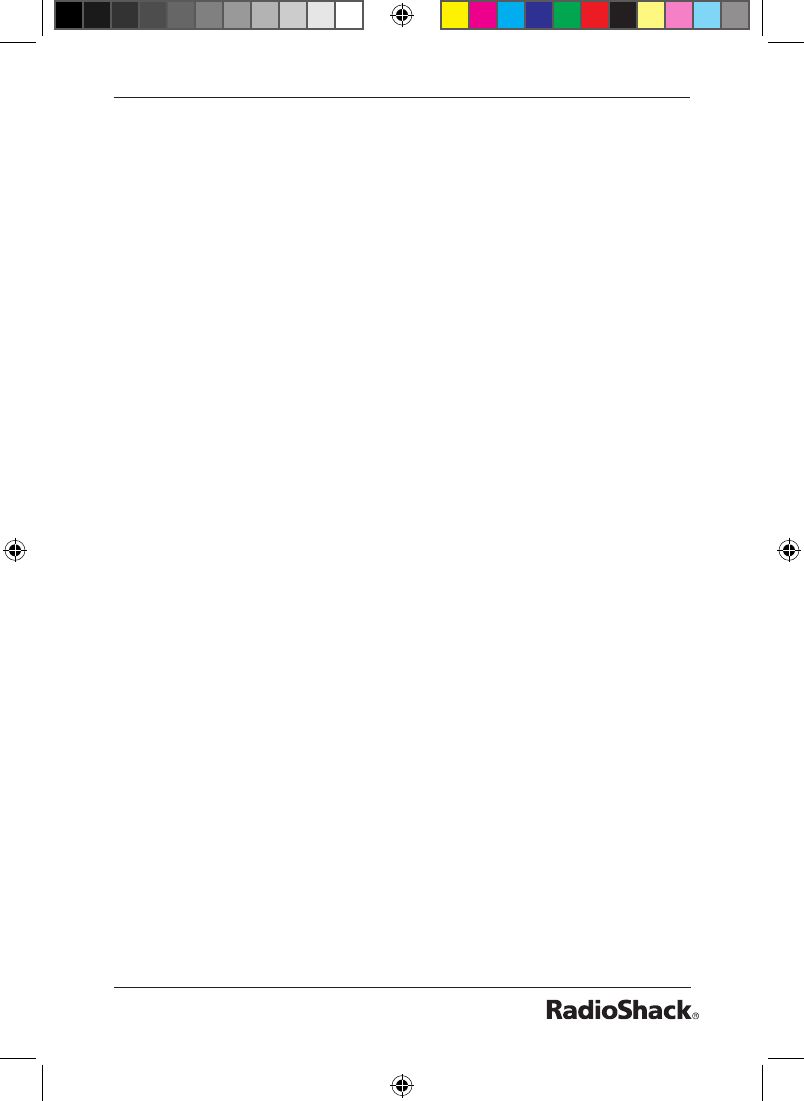
7
DC PWR jack. Using an adapter that does not meet these
specications could damage the CB radio or adapter.
• Always connect the power supply to the CB radio before you
connect it to an AC outlet, and disconnect the power supply
from the AC outlet before you disconnect it from the CB
radio.
Using Vehicle Power
To power your CB radio from your vehicle, you will need a DC
power cord (not included). You may also need a roof-mounted
antenna to improve transmission quality and increase the
transmission range.
1. Turn off the CB radio if it is on.
2. Use the DC power cord to connect the CB’s 12V DC
PWR jack and the vehicle’s 12V power source, such as the
cigarette-lighter socket.
3. Turn on the CB radio to use.
Cautions:
• You must use a Class 2 power supply that provides regulated
12V DC and delivers at least 2.5A. The barrel plug’s center
must be positive and the barrel plug must t the CB radio’s
12V DC PWR jack. Using an adapter that does not meet
these specications could damage the CB radio or adapter.
• Always connect the power supply to the CB radio before you
connect it to the vehicle outlet, and disconnect the power
supply from the outlet before you disconnect it from the CB
radio.
21-1679A_En_111207.indd 7 11/12/2007 17:32:53
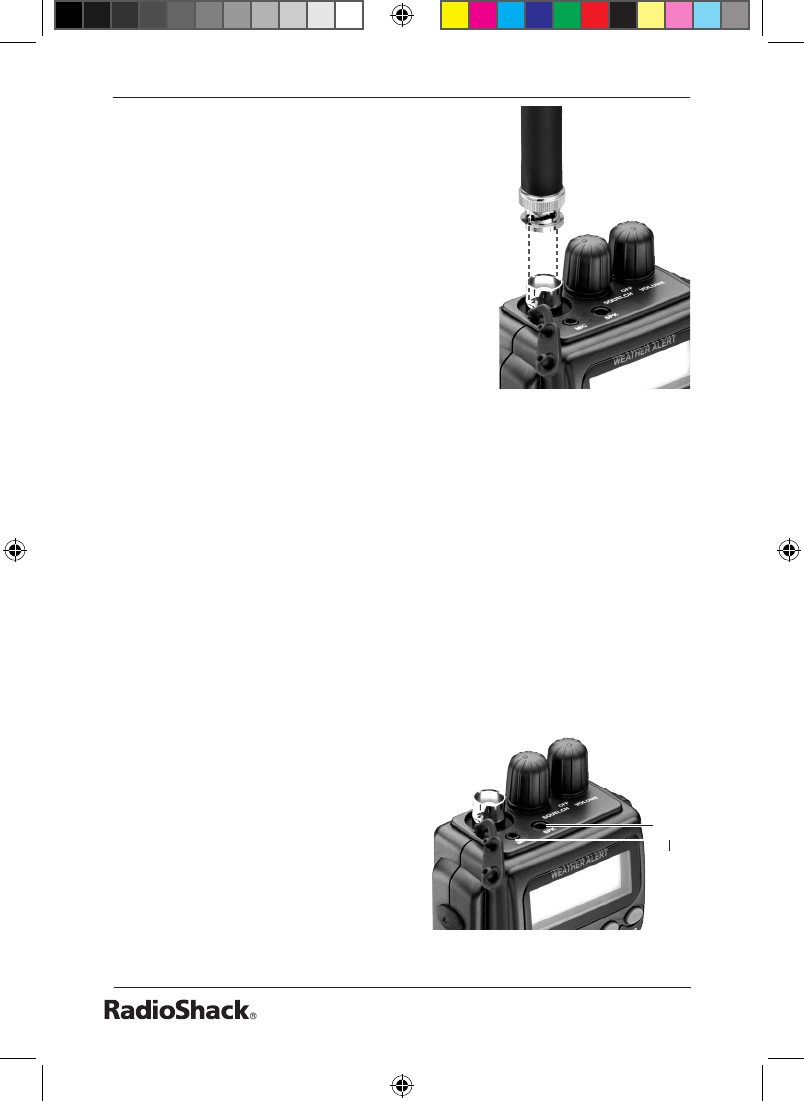
8
Connecting Your CB Radio
Installing the Antenna
To install the supplied antenna, align
the two slots on the antenna connector
with the tabs on the BNC connector
of the CB radio. Push the antenna
connector to the CB radio and rotate
the antenna connector clockwise until it
locks into place.
Installing an Optional Antenna
The CB’s BNC connector allows you to use a variety of optional
antennas, including external mobile antennas and outdoor base
station antennas.
Always use the 50-ohm, RG-58, or RG-8 coaxial cable to connect
an outdoor antenna. If the antenna is over 50 feet from the CB
radio, use the RG-8 low-loss dielectric coaxial cable.
Safety Precaution:
If an outside antenna is installed, be sure the antenna system is
grounded so as to provide protection against voltage surges and
built-up static charges. When installing the antenna, be careful not
to touch overhead power lines as contact with them might be fatal.
Connecting an External Speaker or Microphone
Connect an external speaker (not
included) to the SPK jack of your
CB radio. This mutes the CB’s
internal speaker.
Connect an external microphone
(not included) to the MIC jack of
your CB radio. This disables the
CB’s internal microphone.
MIC
SPK
21-1679A_En_111207.indd 8 11/12/2007 17:32:55
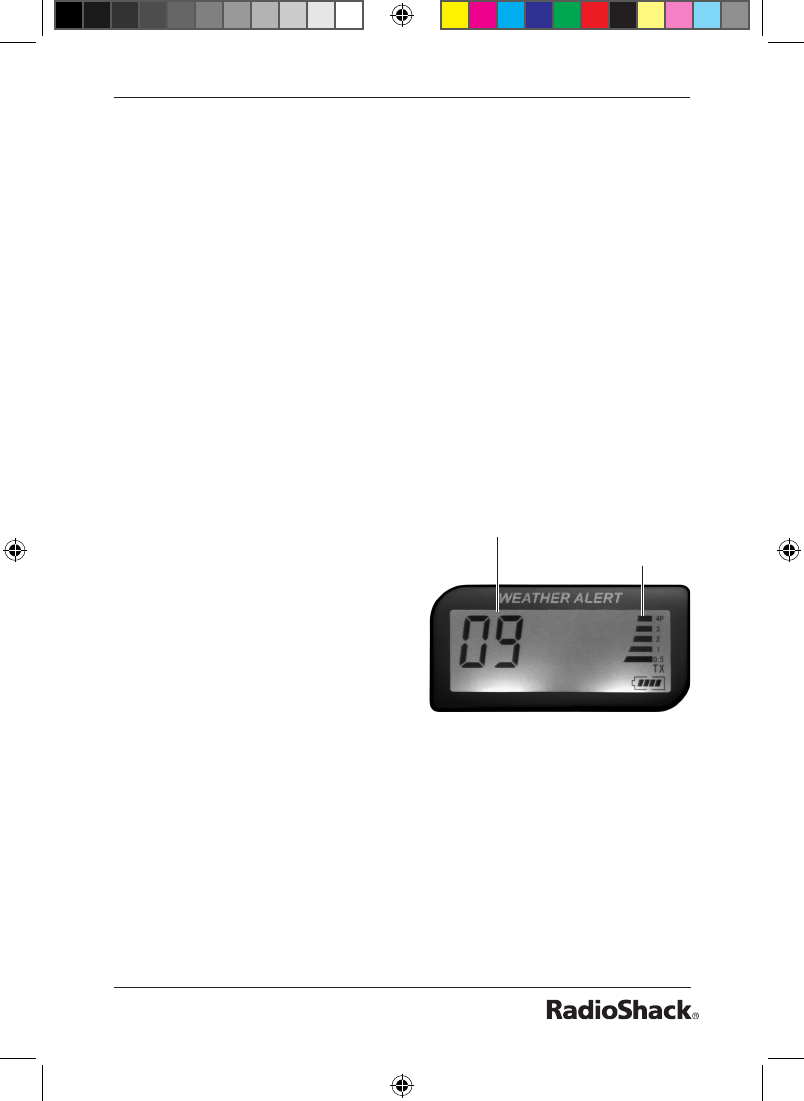
9
Operating Your CB Radio
Receiving
1. Turn SQUELCH fully anticlockwise.
2. Turn on the CB radio. A channel number and the signal
meter appear. If necessary, press CB/WX so that a channel
number and the signal meter appear.
3. Press ▲ or ▼ to select the desired channel.
4. Adjust OFF/VOLUME to the desired volume level.
5. Slowly turn SQUELCH back clockwise just until the noise stops.
Note: Do not turn SQUELCH too far clockwise because you
might cut out weak signals.
RX below the signal meter indicates the CB radio is ready to
receive transmissions.
Transmitting
Test receiving transmissions on
your CB Radio before trying to
transmit a message.
To transmit a message:
1. Press and hold PTT. TX
appears below the signal
meter and the signal meter
shows the output level. Hold
the CB radio 2–3 inches from your mouth and speak in a
normal voice to the internal microphone.
2. When you nish speaking, release PTT.
Notes:
• If you transmit a message while the CB radio is displaying a
weather alert (see Understanding Digital Weather Alert), the alert
tone stops and WX displays steadily. To stop the alert tone
without transmitting a message, press LOCK/ALERT OFF.
• To avoid overheating the internal circuit, do not press and
hold PTT nonstop for over two minutes.
Signal Meter
Channel Number
21-1679A_En_111207.indd 9 11/12/2007 17:32:55
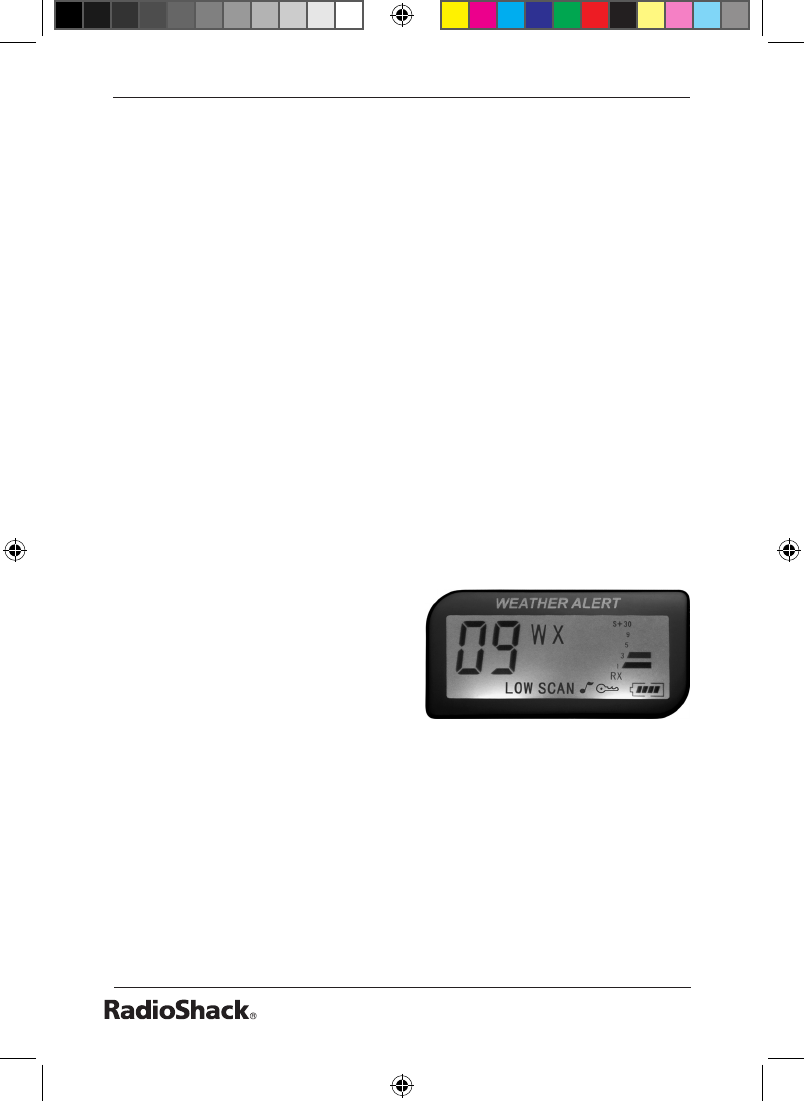
10
Safety Precaution
Your wireless hand-held portable transceiver contains a low
power transmitter. When the Push-to-Talk (PTT) button is
pushed it sends out radio frequency (RF) signals. The device is
authorized to operate at a duty factor not to exceed 50%. In
August 1996, the Federal Communications Commissions (FCC)
adopted RF exposure guidelines with safety levels for hand-held
wireless devices.
To maintain compliance with the FCC’s RF exposure guidelines
hold the transmitter and antenna at least 1 inch (2.5 centimeters)
from your face and speak in a normal voice, with the antenna
pointed up and away from the face. If you wear the handset
on your body while using the headset accessory, use only the
supplied belt clip for this product and when transmitting, take it
out of the belt to ensure that the antenna is at least 1 inch (2.5
centimeters) from your body.
Settings
High/Low Power Level
Press H/L BEEP to switch between low power level (LOW
appears) and high power level.
Note: Low power level reduces
the range of the CB radio.
Backlight
Press LIGHT to turn on the
backlight; press again to turn off. The backlight turns off
automatically after 10 seconds.
Key Tone
To activate the key tone, press and hold H/L BEEP for 2
seconds. ♪ appears. The CB radio sounds a beep when you
press any key except PTT.
To disable the key tone, press and hold H/L BEEP for 2 seconds
again so that ♪ disappears.
21-1679A_En_111207.indd 10 11/12/2007 17:32:56
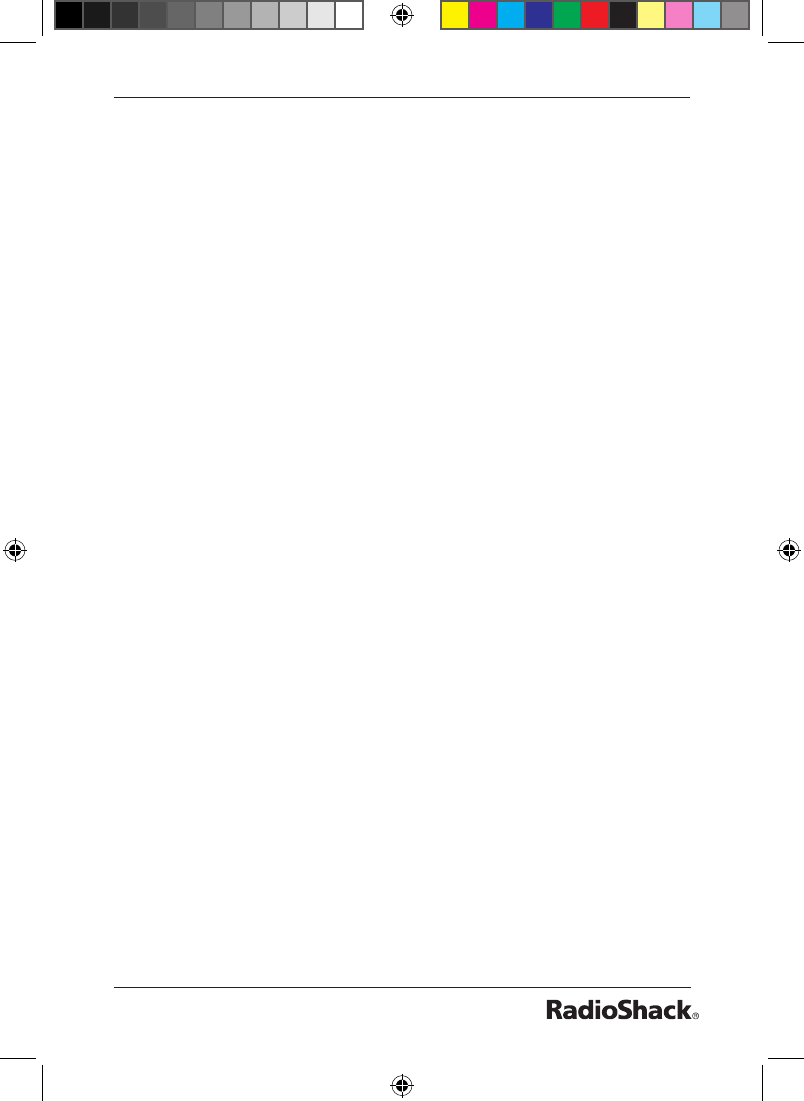
11
Key Lock
To activate key lock, press and hold LOCK for 2 seconds.
6
appears. This locks all keys except PTT and LIGHT. To
unlock key control, press and hold LOCK for 2 seconds again.
Power Save
If you do not press any key or if the CB radio does not receive
any signal for about 10 seconds, the CB radio automatically
enters power save mode. P. SAVE ashes.
Scanning Channels
1. Press CB/WX to select the CB or weather mode.
2. Press and hold CH9/19 SCAN for 2 seconds. SCAN appears,
and the CB radio scans through all channels in the selected
band. When it receives a strong signal, scanning stops.
3. To deactivate scanning, press and hold CH9/19 SCAN for 2
seconds or press the ▲ or ▼ key.
Notes:
• When you turn on the CB radio for the rst time, the scan
feature is automatically set to on in the weather band.
• To change weather channels manually, press the ▲ or ▼ key.
Using Channels 9 and 19
Channel 9 is reserved for motorist assistance and for reporting
emergency information about accidents, hazardous road
conditions, etc. Channel 19 is used by truck drivers for general
communication purposes.
Press CH9/19 SCAN once to select channel 9, press again
to select channel 19, press again to return to the previously
selected channel.
Notes:
• When you select channel 9 or 19, you cannot press ▲ or ▼ to
change channels.
• Always give priority to emergency messages on channel 9.
21-1679A_En_111207.indd 11 11/12/2007 17:32:57
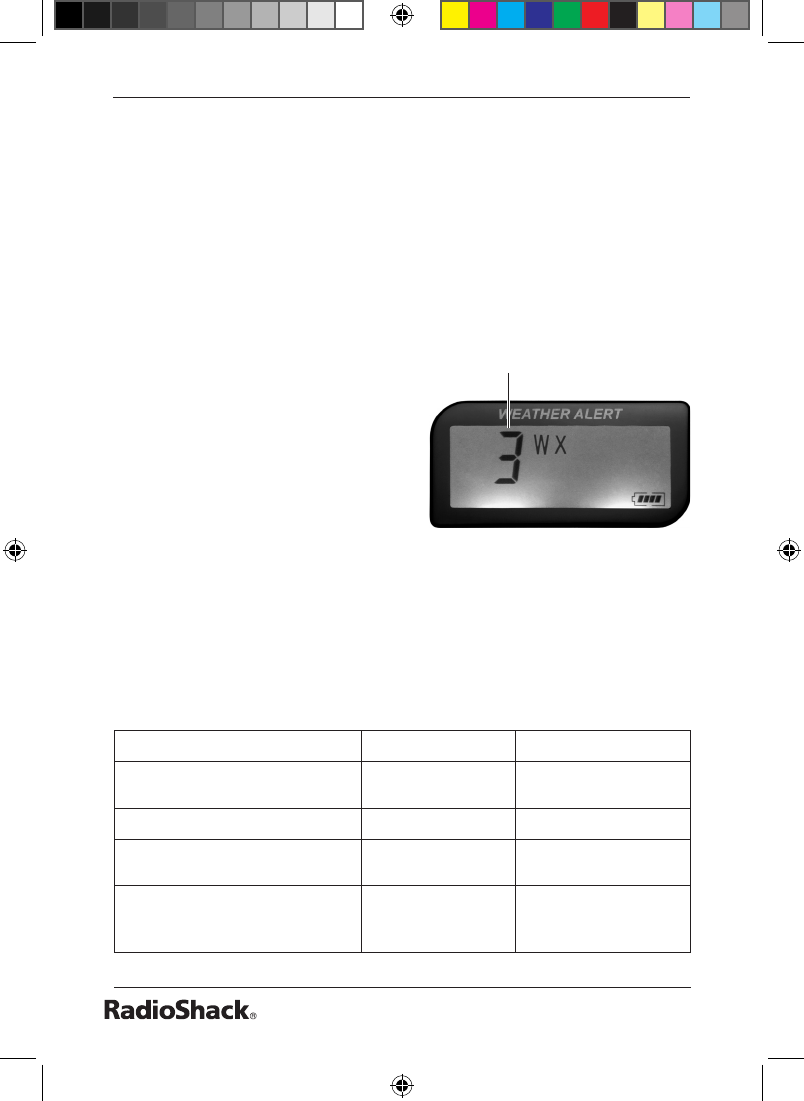
12
Listening to the Weather Band
The FCC has allocated channels for use by National Oceanic
and Atmospheric Administration (NOAA). Regulatory agencies
in other countries have also allocated channels for use by their
weather reporting authorities.
NOAA and your local weather reporting authority broadcast
your local forecast and regional weather information on one or
more of these channels.
Listening to a Weather Channel
Press CB/WX to select weather
mode. WX appears. The CB
radio scans through the weather
channels and then stops on the
strongest channel. Press CB/WX
again to return to CB mode.
Note: You cannot adjust the
power level or switch to
channel 9 or 19 while
listening to a weather channel.
Turning Digital Weather Alert On and Off
• Digital weather alert automatically scans in the background
when you select the CB mode, unless you turn it off.
• Press LOCK/ALERT OFF to turn digital weather alert on and off.
In CB mode, WX displays as described below.
WX Appearance Weather Alert Weather Signal
WX not present Not on Not scanning for
signal
WX flashes On No signal found
WX displays steadily On Signal found and
locked in
WX displays steadily for 2
seconds and then flashes
twice
On Signal found;
scanning for signal
Weather Channel
21-1679A_En_111207.indd 12 11/12/2007 17:32:57
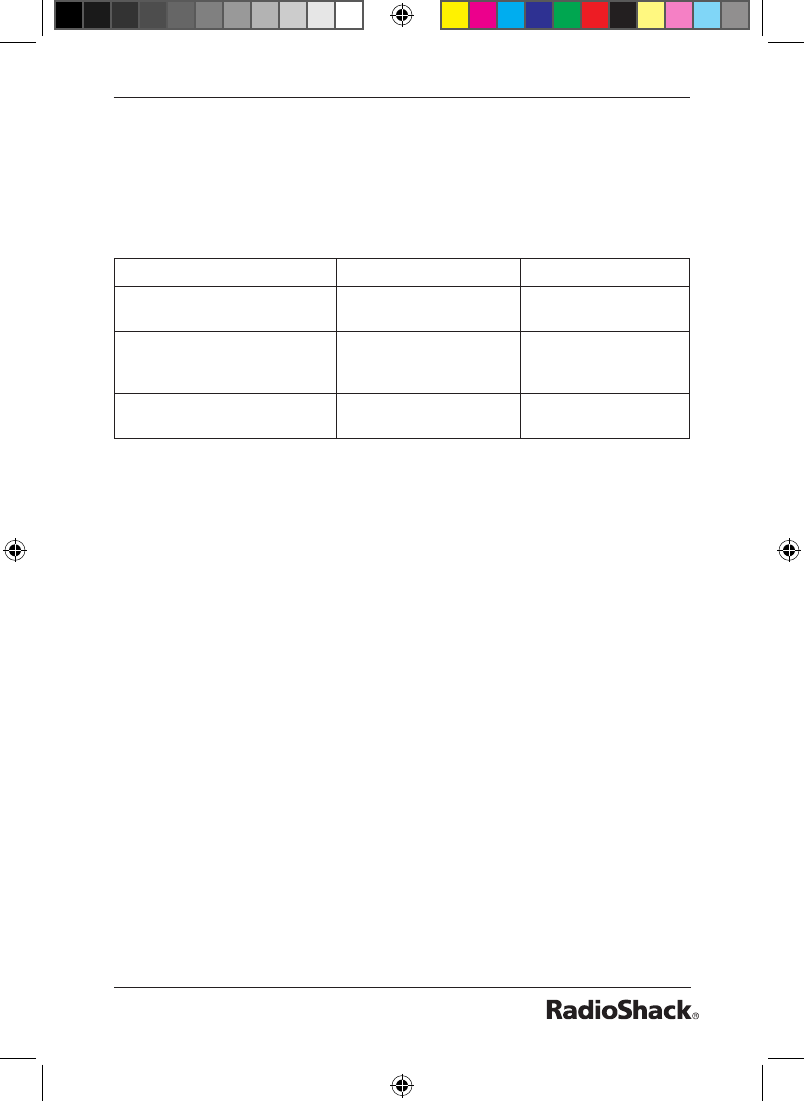
13
Understanding Digital Weather Alert
The weather service precedes each weather alert with a digitally-
encoded SAME (Specic Area Message Encoding) signal, then
a 1050 Hz tone. When your local weather station broadcasts
a weather alert signal, the CB radio sounds an alert tone and
displays a message showing the alert level.
SAME Event Code Alert Tone Message
A (Watch) Watch alert
10 seconds WCH (Watch)
W (Warning)
TOR (Tornado)
SVR (Severe)
Warning alert
10 seconds WRN (Warning)
S (Statement)
RWT (Test) Statement alert
10 seconds ADV (Advisory)
Notes:
• The CB radio does not display the actual location referenced
by SAME messages. It uses only the message portion of the
SAME signal.
• If severe weather threatens, do not wait for an alert tone;
tune to the weather broadcast and monitor the weather
information.
• If a weather signal ends, the CB radio beeps three times
(when the key tone is turned on) and only when the weather
signal ends the rst time, then WX ashes to indicate there is
no signal.
21-1679A_En_111207.indd 13 11/12/2007 17:32:57
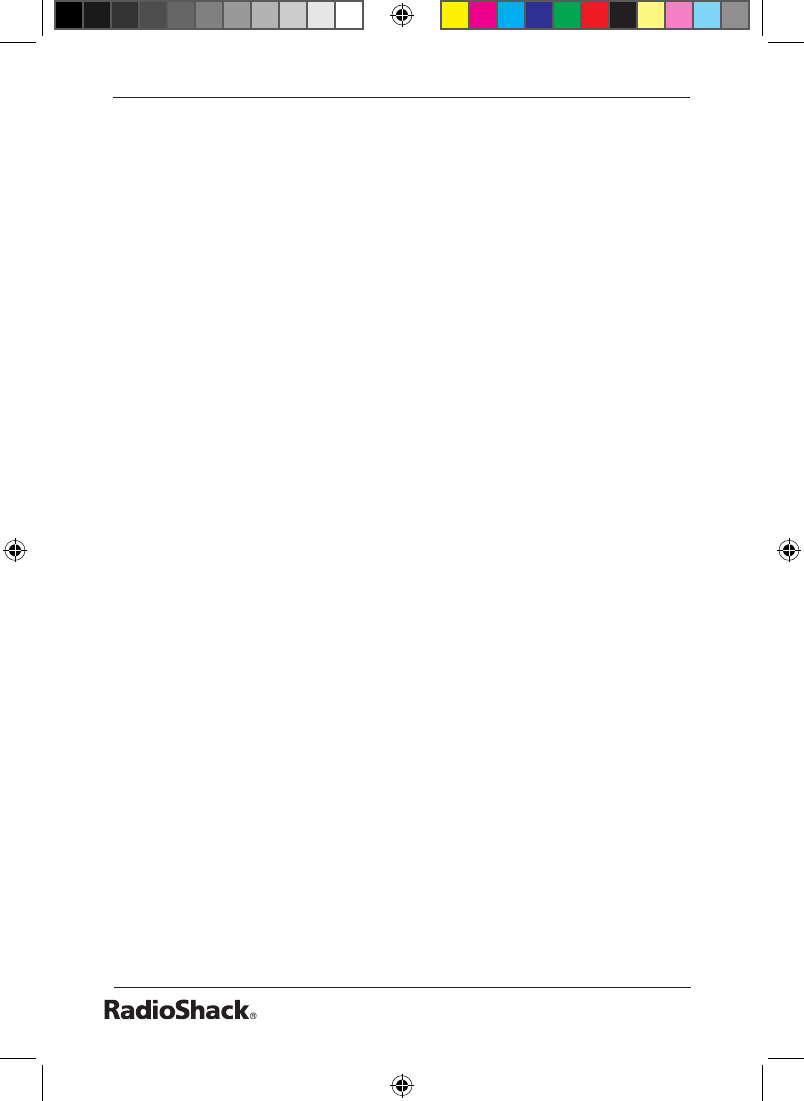
14
Additional Information
Legal Use of Your CB Radio
The CB Radio service is a private, two-way, short-distance voice
communications service for personal or business activities. For
rules regarding legal CB radio use, see the included Plain English
Rules – Citizens Band Radio Service published by the FCC.
Common Uses for a CB Radio
• Warn of trafc tie-ups ahead.
• Help truck drivers and delivery personnel learn road and
trafc conditions and get assistance in locating destinations.
• Provide fast help in the event of emergency or breakdown.
• Help construction crews coordinate the activities of different
work crews.
• Assist communication between security ofcers.
• Provide weather and road information.
• Contact friends or other CB users on trips.
• Keep in touch with your ofce or home.
• Bring more fun for camping, shing, and other sports; help
locate a friend or nd out what’s cooking back at camp.
Transmission Courtesy
• Wait for a pause in someone else’s transmission before you
ask for a break.
• If you do not receive an answer to your call after a second
attempt, sign off and wait several seconds before trying again.
• Do not hold down PTT when you are not talking. (This is
called dead keying.)
• Assist callers with directions, information about road
conditions, and any other reasonable requests.
Transmission Range
The maximum range and quality of CB transmissions vary
depending on the following conditions:
21-1679A_En_111207.indd 14 11/12/2007 17:32:58
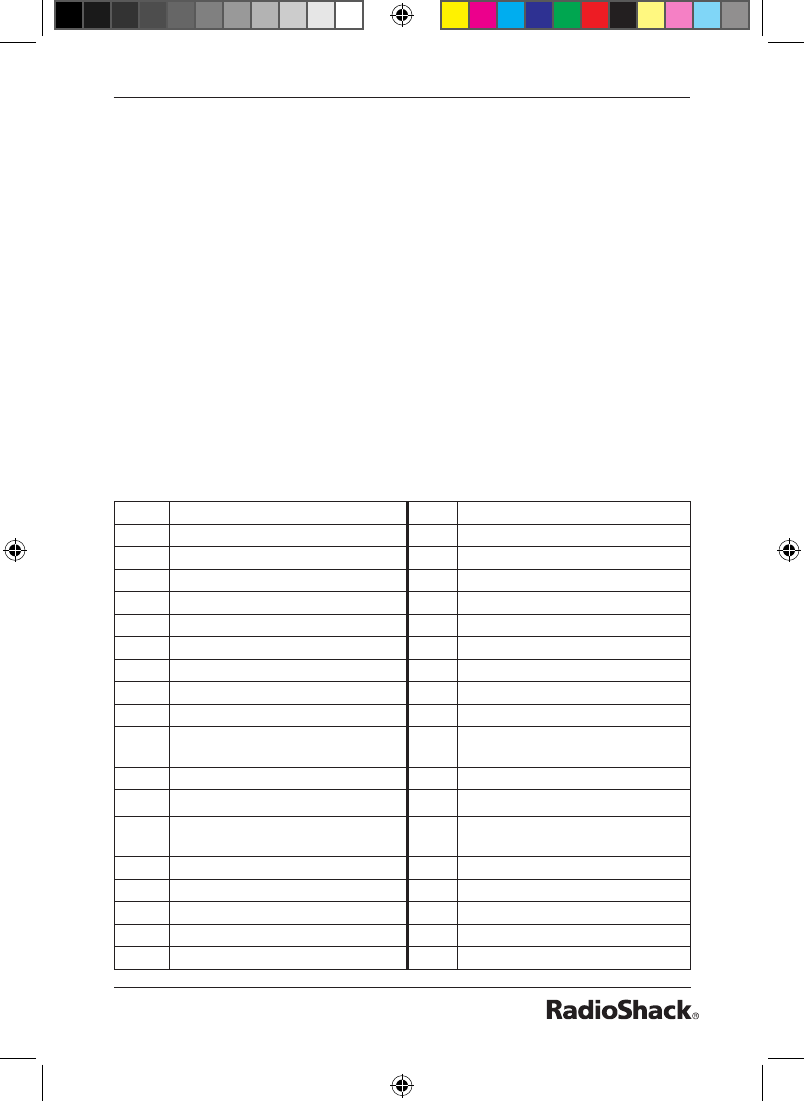
15
• Type and quality of the antenna.
• Height of the antenna’s mounting location (the higher the
antenna, the better the signal’s range).
• Surrounding terrain (mountains and tall buildings limit the range).
• Weather conditions.
• Number of nearby CBs operating on the same channel.
Note: Your CB radio’s transmission range is generally line-of-
sight. To ensure maximum range, always keep the battery
pack fully charged or use fresh batteries.
Common 10-Codes
Citizens Band radio operators have largely adopted the 10-
codes for standard questions and answers. These codes permit
faster communication and better understanding in noisy areas.
The following table lists some of the more common codes and
their meanings:
Code Meaning Code Meaning
10-1 Receiving poorly 10-22 Report in person to____
10-2 Receiving well 10-23 Stand by
10-3 Stop transmitting 10-25 Can you contact____
10-4 OK, message received 10-26 Disregard last information
10-5 Relay message 10-27 I am moving to channel
10-6 Busy, stand by 10-28 Identify your station
10-7 Out of service 10-32 I will give you a radio check
10-8 In service 10-33 Emergency trafc
10-9 Repeat message 10-36 Correct time is____
10-10 Transmission completed,
standing by 10-37 Wrecker needed at____
10-11 Talking too rapidly 10-38 Ambulance needed at____
10-12 Visitors present 10-41 Please turn to channel____
10-13 Advise Weather/Road
conditions 10-42 Trafc accident at____
10-17 Urgent business 10-43 Trafc tie-up at____
10-18 Anything for us? 10-50 Break channel
10-19 Nothing for you. Return to base 10-62 Unable to copy; use telephone
10-20 My location is____ 10-70 Fire at____
10-21 Call by telephone
21-1679A_En_111207.indd 15 11/12/2007 17:32:58
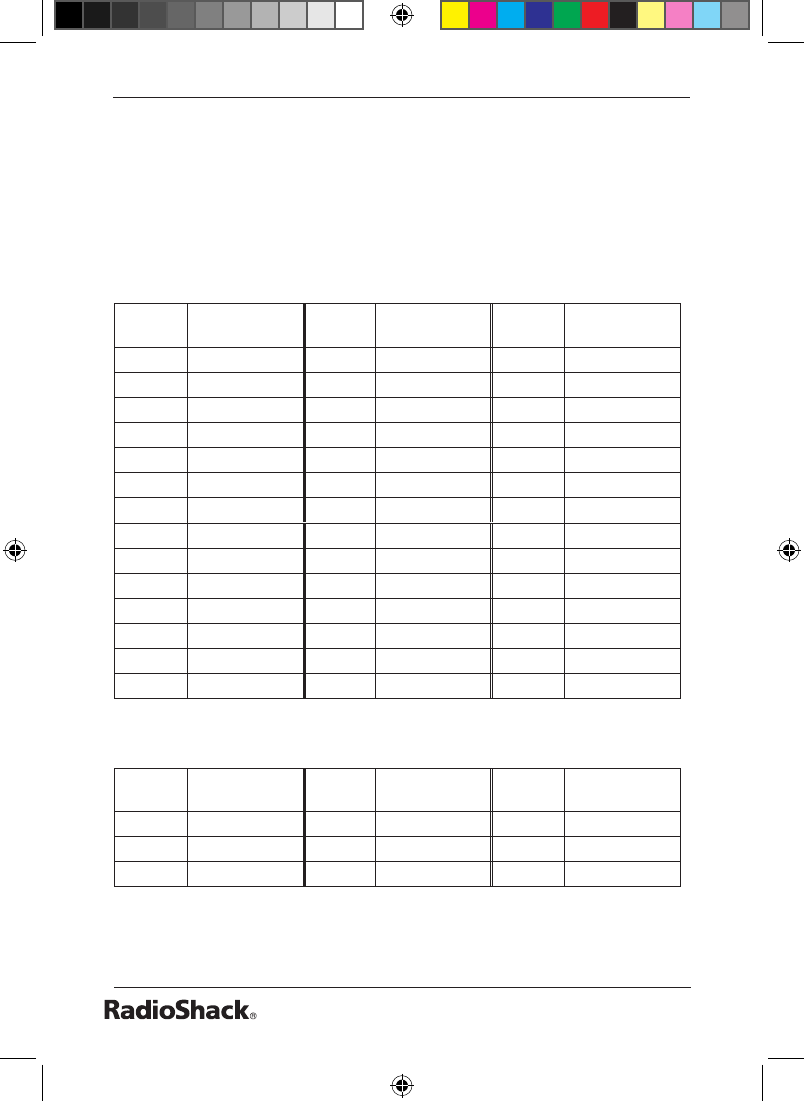
16
Note: Although this table lists the meanings of the 10-codes
in the form of a statement, they can also be phrased
as questions (10-6: Are you busy? 10-20: What is your
location?)
Frequency Range
Your CB radio receives and transmits on the following 40 CB
channels:
Channel Frequency
(MHz) Channel Frequency
(MHz) Channel Frequency
(MHz)
1 26.965 15 27.135 28 27.285
2 26.975 16 27.155 29 27.295
3 26.985 17 27.165 30 27.305
4 27.005 18 27.175 31 27.315
5 27.015 19 27.185 32 27.325
6 27.025 20 27.205 33 27.335
7 27.035 21 27.215 34 27.345
8 27.055 22 27.225 35 27.355
9 27.065 23 27.255 36 27.365
10 27.075 24 27.235 37 27.375
11 27.085 25 27.245 38 27.385
12 27.105 26 27.265 39 27.395
13 27.115 27 27.275 40 27.405
14 27.125
In addition, your CB radio can receive these weather service
channels:
Channel Frequency
(MHz) Channel Frequency
(MHz) Channel Frequency
(MHz)
1 162.400 4 162.475 7 162.550
2 162.425 5 162.500
3 162.450 6 162.525
21-1679A_En_111207.indd 16 11/12/2007 17:32:58
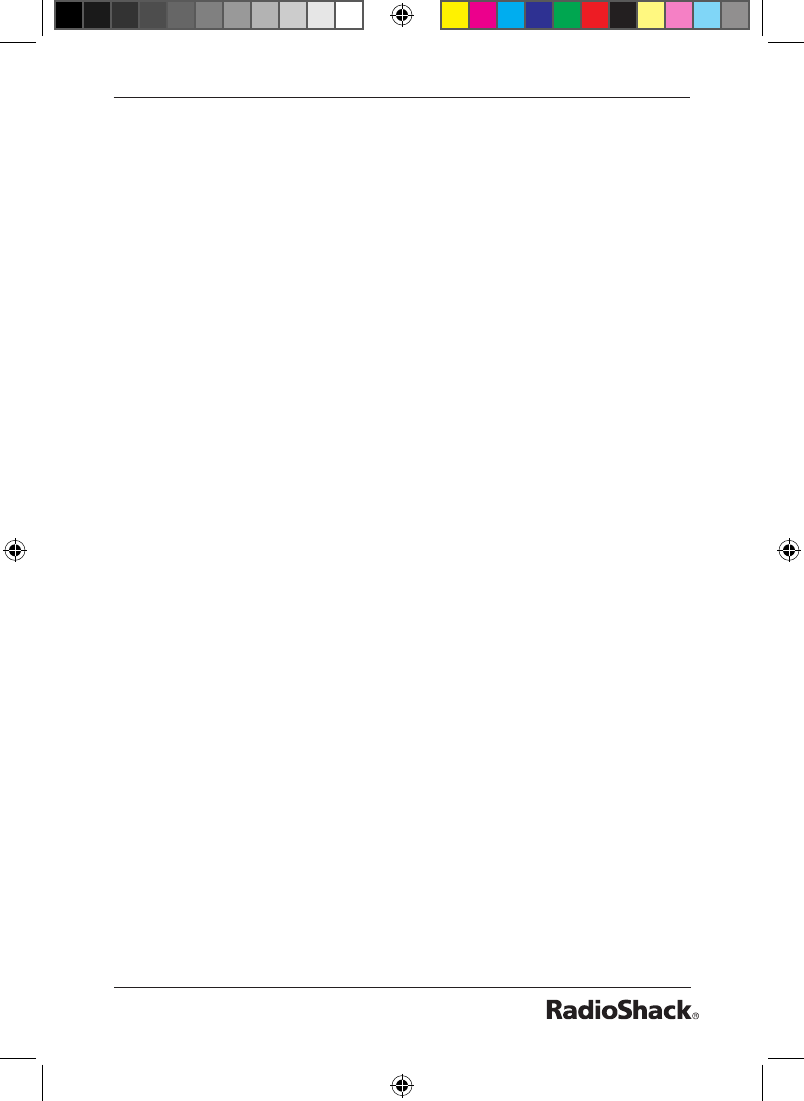
17
Specifications
Receiver
Frequency Coverage ........ 26.965~27.405 MHz, 162.400~162.550 MHz
Sensitivity ...........................................................................1 µV for 10 dB
Adjacent Channel Rejection ((S+N)/N) ........................................... 60 dB
Squelch ................................................................ Adjustable from 0.5 µV
Audio Output Power (10% THD) ................................................ 400 mW
Current Drain ............................. 80 mA (Standby); 400 mA (Max. Audio)
Transmitter
Frequency Coverage ............................................... 26.965~27.405 MHz
Power Output ........................................................ 3 W (High); 1 W (Low)
Conducted Spurious Emission Harmonics ..................................... 60 dB
Type of Modulation ............................................................................. A3
Frequency Tolerance ....................................................................0.002%
Antenna Impedance ......................................................................... 50 Ω
Current Drain (@ Max. Modulation) ...............1.3 A (High); 700 mA (Low)
Dimensions (H×W×D) .......... 7.4 × 2.6 × 1.8 inch (186 × 65 × 47 mm)
Weight (including battery pack & antenna) ...................... 18.3 oz (520 g)
Specications are subject to change and improvement without notice.
Actual product may vary from the images found in this document.
Care
Keep the CB radio dry; if it gets wet, wipe it dry immediately.
Use and store the CB radio only normal temperature
environments. Handle the CB radio carefully; do not drop it.
Keep the CB radio away from dust and dirt, and wipe it with a
damp cloth occasionally to keep it looking new.
Modifying or tampering with the CB radio’s internal components
can cause a malfunction and might invalidate its warranty and
avoid your FCC authorization to operate it. If your CB radio is
not performing as it should, take it to your local RadioShack
store for assistance.
21-1679A_En_111207.indd 17 11/12/2007 17:32:58
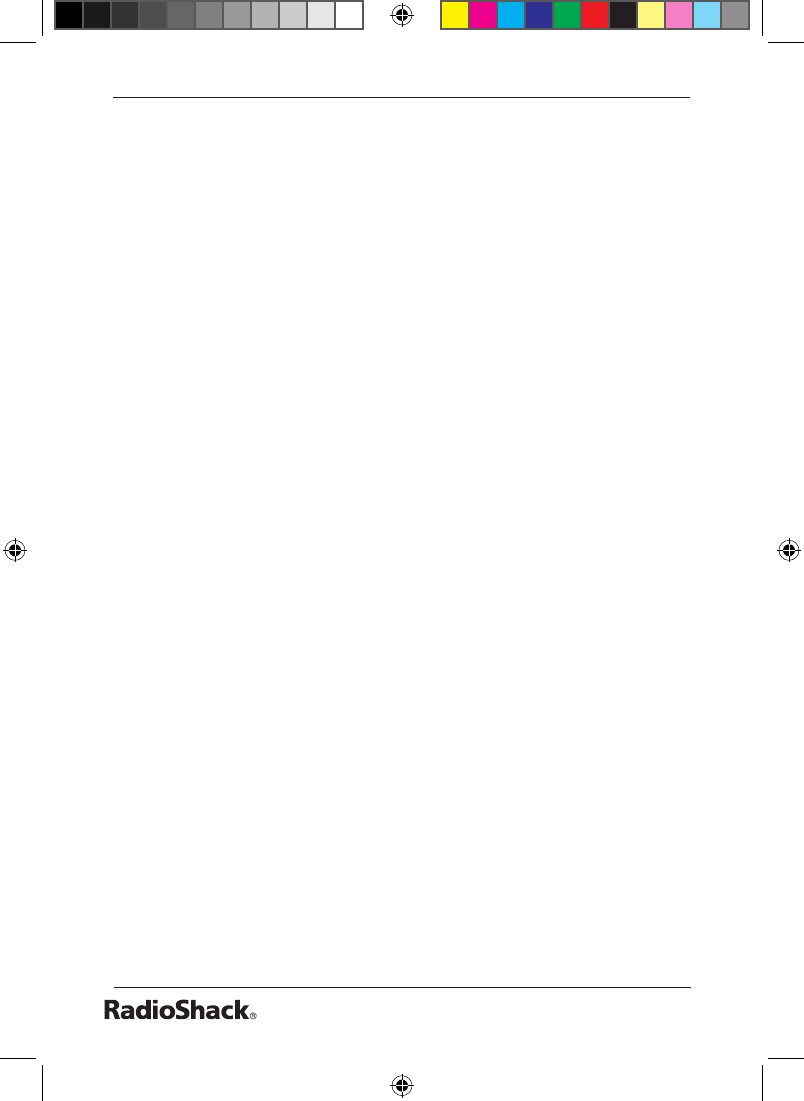
18
RF Emissions Information
This equipment has been tested and found to comply with the limits
for a Class B digital device, pursuant to Part 15 of the FCC Rules.
These limits are designed to provide reasonable protection against
harmful interference in a residential installation. This equipment
generates, uses, and can radiate radio frequency energy and, if not
installed and used in accordance with the instructions, may cause
harmful interference to radio communications. However, there is no
guarantee that interference will not occur in a particular installation. If
this equipment does cause harmful interference to radio or television
reception, which can be determined by turning the equipment off and
on, the user is encouraged to try to correct the interference by one or
more of the following measures:
• Reorient or relocate the receiving antenna.
• Increase the separation between the equipment and receiver.
• Connect the equipment into an outlet on a circuit different from that
to which the receiver is connected.
Consult your local RadioShack store or an experienced radio/TV
technician for help. If you cannot eliminate the interference, the FCC
requires that you stop using your product. Changes or modications
not expressly approved by RadioShack may cause interference and
void the user’s authority to operate the equipment.
This device complies with Part 15 of the FCC Rules. Operation is
subject to the following two conditions: (1) this device may not cause
harmful interference, and (2) this device must accept any interference
received, including interference that may cause undesired operation.
Warnings:
• Any adjustment to this equipment is recommended to be
performed by or under the immediate supervision and responsibility
of a person certied as technically qualied to perform transmitter
maintenance and repair duties in the private land mobile services
and xed services by an organization or committee representative of
users of those services.
• Replacement of any transmitter component (crystal, semiconductor,
etc.) for this equipment could result in violation of FCC rules.
21-1679A_En_111207.indd 18 11/12/2007 17:32:58
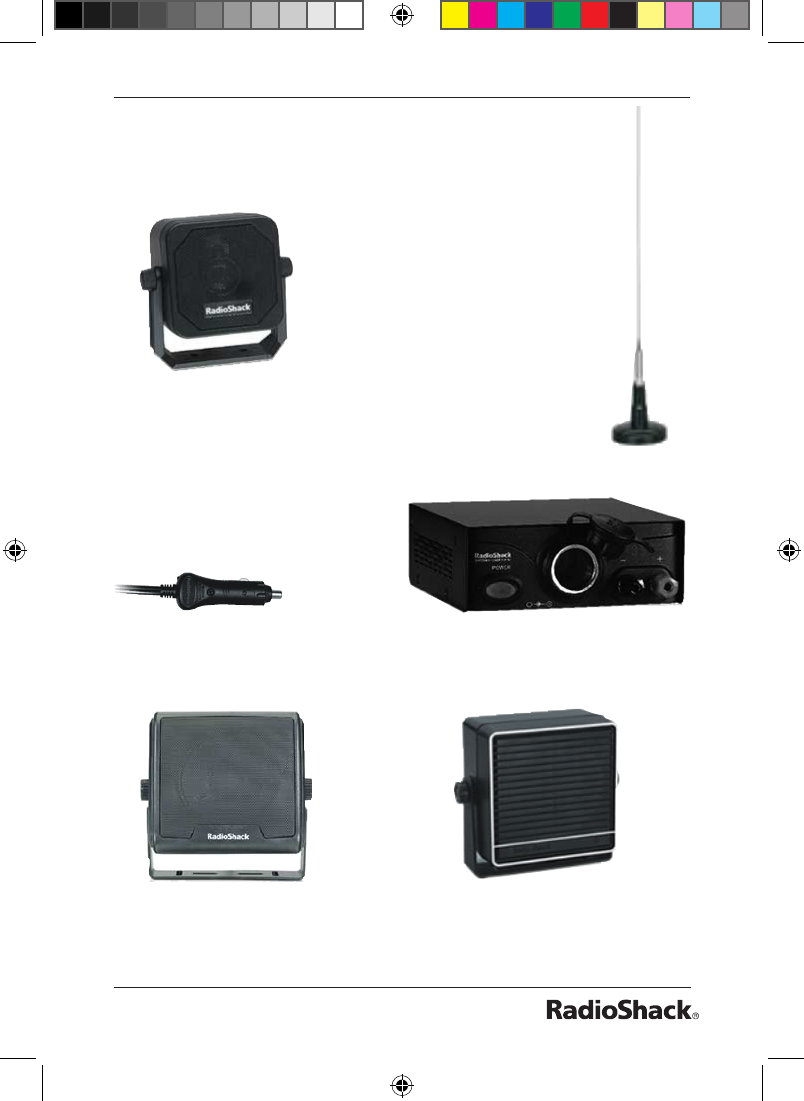
19
Do Stuff
Do more with your CB radio.
DC Power Cord
• Power up in your car.
13.8VDC 3-Amp Power Supply
• Power up in your home.
25-watt, 39” Whip,
Magnetic-mount
Mobile CB Antenna
• Receive more, and
• Transmit farther in
your car.
7.5-Watt Amplied Mobile
Extension Speaker
• Amplify over loud noises.
5-Watt Heavy-duty Extension
Speaker
• Amplify at home or in the
car.
Mini Extension Speaker
• Clip it to your visor.
• Set it on your dash.
21-1679A_En_111207.indd 19 11/12/2007 17:32:59
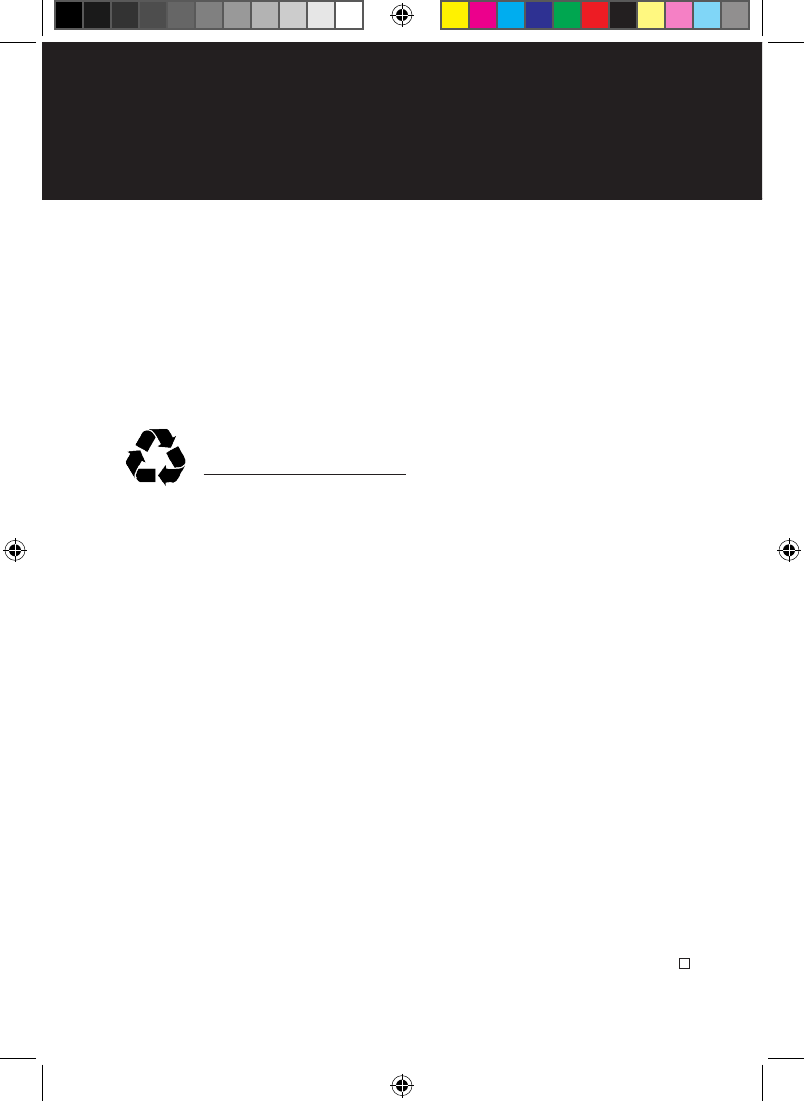
©2007. RadioShack Corporation.
All rights reserved. RadioShack and RadioShack.com
are trademarks used by RadioShack Corporation.
11A07
21-1679A
AO0300AAA1
Printed in China
Limited 90-Day Warranty
This product is warranted by RadioShack against manufacturing defects
in material and workmanship under normal use for ninety (90) days from
the date of purchase from RadioShack company-owned stores and
authorized RadioShack franchisees and dealers. For complete warranty
details and exclusions, check with your local RadioShack store.
RadioShack Customer Relations
300 RadioShack Circle, Fort Worth, TX 76102 04/04
Protect the environment by recycling used electronics. Go to
www.ecyclingcentral.com to nd a recycle location near you.
21-1679A_En_111207.indd 20 11/12/2007 17:32:59